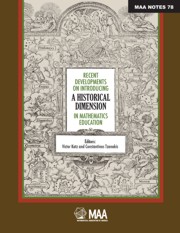Book contents
- Frontmatter
- Preface
- Contents
- 1 Teaching with Primary Historical Sources: Should it Go Mainstream? Can it?
- 2 Dialogismin Mathematical Writing: Historical, Philosophical and Pedagogical Issues
- 3 The Process of Mathematical Agreement: Examples from Mathematics History and an Experimental Sequence of Activities
- 4 Researching the History of Algebraic Ideas from an Educational Point of View
- 5 Equations and Imaginary Numbers: A Contribution from Renaissance Algebra
- 6 The Multiplicity of Viewpoints in Elementary Function Theory: Historical and Didactical Perspectives
- 7 From History to Research in Mathematics Education: Socio-Epistemological Elements for Trigonometric Functions
- 8 Harmonies in Nature: A Dialogue Between Mathematics and Physics
- 9 Exposure to Mathematics in the Making: Interweaving Math News Snapshots in the Teaching of High-School Mathematics
- 10 History, Figures and Narratives in Mathematics Teaching
- 11 Pedagogy, History, and Mathematics: Measure as a Theme
- 12 Students' Beliefs About the Evolution and Development of Mathematics
- 13 Changes in Student Understanding of Function Resulting from Studying Its History
- 14 Integrating the History of Mathematics into Activities Introducing Undergraduates to Concepts of Calculus
- 15 History in a Competence Based Mathematics Education: A Means for the Learning of Differential Equations
- 16 History of Statistics and Students' Difficulties in Comprehending Variance
- 17 Designing Student Projects for Teaching and Learning Discrete Mathematics and Computer Science via Primary Historical Sources
- 18 History of Mathematics for Primary School Teacher Education Or: Can You Do Something Even if You Can't Do Much?
- 19 Reflections and Revision: Evolving Conceptions of a Using History Course
- 20 Mapping Our Heritage to the Curriculum: Historical and Pedagogical Strategies for the Professional Development of Teachers
- 21 Teachers' Conceptions of History of Mathematics
- 22 The Evolution of a Community of Mathematical Researchers in North America: 1636–1950
- 23 The Transmission and Acquisition of Mathematics in Latin America, from Independence to the First Half of the Twentieth Century
- 24 In Search of Vanishing Subjects: The Astronomical Origins of Trigonometry
- About the Editors
12 - Students' Beliefs About the Evolution and Development of Mathematics
- Frontmatter
- Preface
- Contents
- 1 Teaching with Primary Historical Sources: Should it Go Mainstream? Can it?
- 2 Dialogismin Mathematical Writing: Historical, Philosophical and Pedagogical Issues
- 3 The Process of Mathematical Agreement: Examples from Mathematics History and an Experimental Sequence of Activities
- 4 Researching the History of Algebraic Ideas from an Educational Point of View
- 5 Equations and Imaginary Numbers: A Contribution from Renaissance Algebra
- 6 The Multiplicity of Viewpoints in Elementary Function Theory: Historical and Didactical Perspectives
- 7 From History to Research in Mathematics Education: Socio-Epistemological Elements for Trigonometric Functions
- 8 Harmonies in Nature: A Dialogue Between Mathematics and Physics
- 9 Exposure to Mathematics in the Making: Interweaving Math News Snapshots in the Teaching of High-School Mathematics
- 10 History, Figures and Narratives in Mathematics Teaching
- 11 Pedagogy, History, and Mathematics: Measure as a Theme
- 12 Students' Beliefs About the Evolution and Development of Mathematics
- 13 Changes in Student Understanding of Function Resulting from Studying Its History
- 14 Integrating the History of Mathematics into Activities Introducing Undergraduates to Concepts of Calculus
- 15 History in a Competence Based Mathematics Education: A Means for the Learning of Differential Equations
- 16 History of Statistics and Students' Difficulties in Comprehending Variance
- 17 Designing Student Projects for Teaching and Learning Discrete Mathematics and Computer Science via Primary Historical Sources
- 18 History of Mathematics for Primary School Teacher Education Or: Can You Do Something Even if You Can't Do Much?
- 19 Reflections and Revision: Evolving Conceptions of a Using History Course
- 20 Mapping Our Heritage to the Curriculum: Historical and Pedagogical Strategies for the Professional Development of Teachers
- 21 Teachers' Conceptions of History of Mathematics
- 22 The Evolution of a Community of Mathematical Researchers in North America: 1636–1950
- 23 The Transmission and Acquisition of Mathematics in Latin America, from Independence to the First Half of the Twentieth Century
- 24 In Search of Vanishing Subjects: The Astronomical Origins of Trigonometry
- About the Editors
Summary
Introduction
Beliefs about the history of mathematics is a topic which is touched upon from time to time in the literature on history in mathematics education, e.g., in Furinghetti [8] and Philippou and Christou [23]. However, when scanning these samples, one soon finds that these concern the beliefs of in-service or pre-service teachers. Studies on students' beliefs about the history of mathematics seem to be rather poorly represented in the literature, if not altogether absent. One reason for this that I can think of is that, in general, studies of beliefs in mathematics education are conducted with the purpose of improving mathematical thinking, learning, and instruction. Beliefs, both cognitive and affective ones, are investigated in order to identify the ‘ingredients’ which do or do not make students capable of solving mathematical tasks or teachers capable of teaching differently and/or more effectively. Certain beliefs are identified as advantageous in the learning of certain mathematical contents, the solving of related tasks, etc., and educational studies are then conducted on how to change already existing beliefs into these more favorable ones. In this sense beliefs are regarded as means—or tools—to achieve understanding in the individuals' constructive learning process. Only rarely is providing students or teachers with certain beliefs, e.g., by changing existing ones, about mathematics or mathematics as a discipline considered as a goal in itself. And when this is done, the term ‘beliefs’ is usually not used. Instead mathematical appreciation, mathematical awareness, or providing students with a more profound image of what mathematics is, are the words or phrases more commonly used (e.g., [7, 20, 5]).
- Type
- Chapter
- Information
- Publisher: Mathematical Association of AmericaPrint publication year: 2011
- 1
- Cited by



